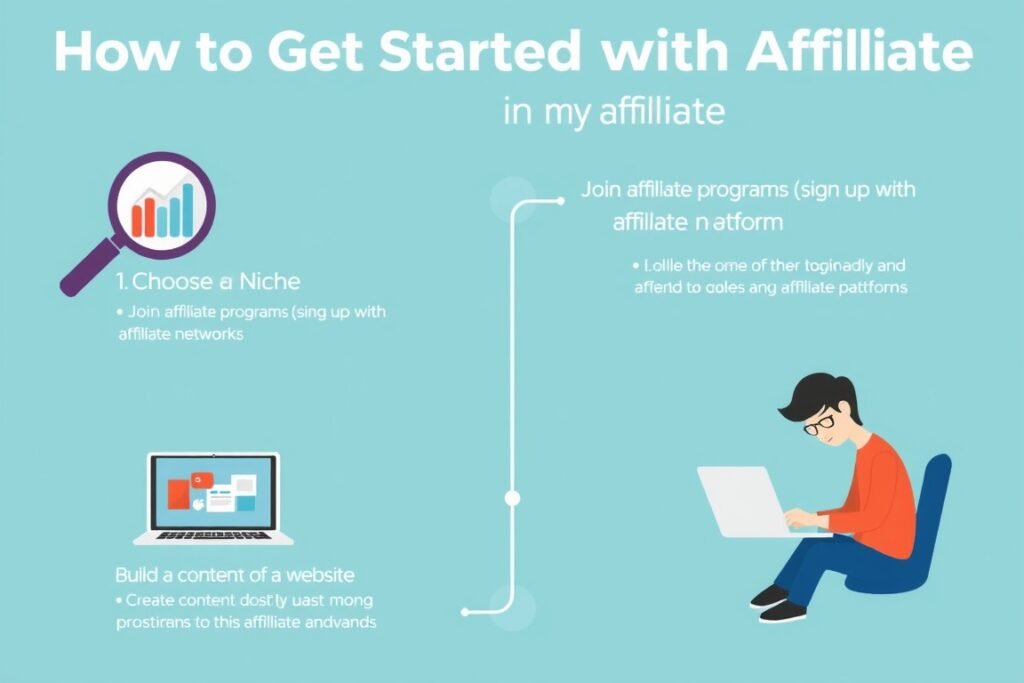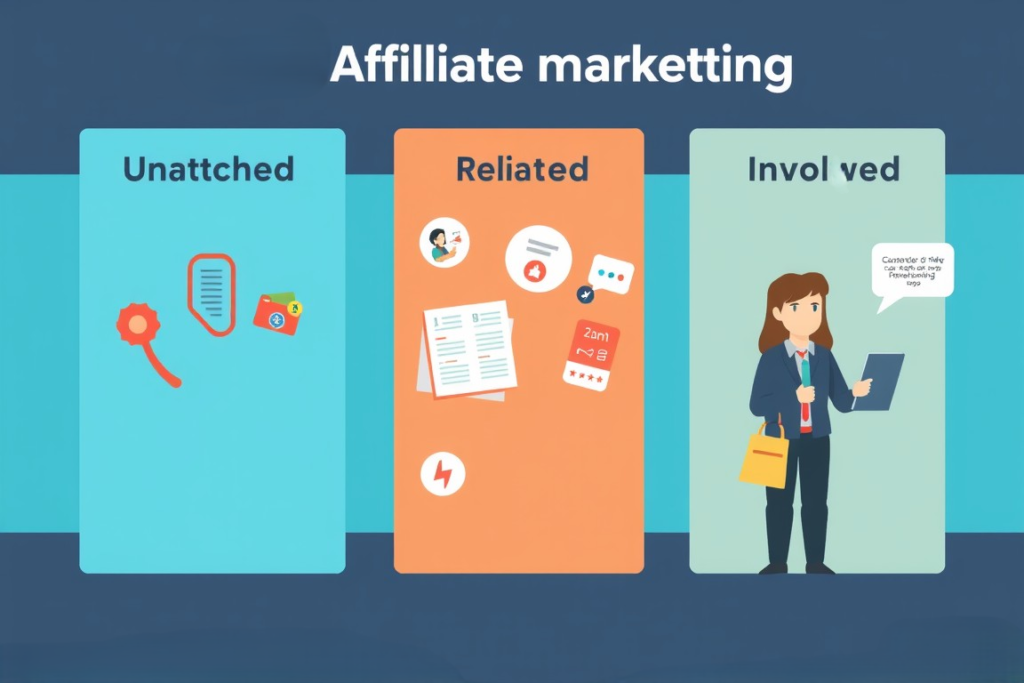Introduction
The rise of online entrepreneurship has made affiliate marketing in 2025 one of the most sought-after ways to generate passive income in 2025. With minimal investment, anyone can tap into the potential of this lucrative business model, whether you’re a seasoned marketer or just starting your online journey. In this section, we’ll explore what affiliate marketing is and why 2025 is the perfect time to start building your passive income stream. The benefits of affiliate marketing go beyond simple earnings; it offers flexibility, scalability, and the chance to be your own boss. By the end of this article, you’ll have a clear roadmap to start affiliate marketing, understanding both its rewards and challenges.
What is Affiliate Marketing?

Affiliate marketing in 2025 is a performance-based earning model where an individual (the affiliate) earns a commission for promoting someone else’s product or service. The affiliate shares a unique link, and every time a purchase is made through that link, the affiliate earns a share of the revenue. It’s an ideal way to earn passive income because once the content (such as blog posts, videos, or social media posts) is created, it can continue to generate commissions long after it’s published. The appeal of affiliate marketing lies in the simplicity—no need to create your own products or handle customer service, making it accessible to virtually anyone with an internet connection and some marketing skills.
Introduce the Key Players Involved in Affiliate Marketing

To truly understand affiliate marketing, it’s essential to know the roles of the key players involved:
- Merchants (Advertisers): These are the businesses or individuals who create and sell the products or services. They rely on affiliates to promote their offerings and generate sales.
- Affiliates (Publishers): These are the individuals or companies who promote the merchant’s products to their audience. Affiliates earn commissions through the sales or leads they generate.
- Consumers (Customers): The end users who make purchases through the affiliate’s promotional efforts. Of course, Without consumers, the affiliate marketing process wouldn’t be possible.
- Affiliate Networks: These are platforms that connect merchants and affiliates, providing tracking, reporting, and payment services. Popular networks include ShareASale, ClickBank, and CJ Affiliate.
Understanding the role of each player helps demystify how affiliate marketing works and illustrates the value exchange at every stage.
Benefits of Affiliate Marketing

One of the primary reasons people are flocking to affiliate marketing in 2025 is its abundance of benefits.
- Low Startup Costs: Unlike traditional businesses, there is no need to create products, hold inventory, or manage logistics. You can start with a blog, YouTube channel, or social media account at a minimal cost.
- Passive Income Potential: Once you’ve set up your affiliate marketing content, it has the potential to earn money continuously through affiliate links. This makes it an ideal way to create a passive income stream.
- Flexibility and Freedom: You can work from home or anywhere in the world and set your schedule. Whether it’s a side hustle or a full-time venture, affiliate marketing gives you the freedom to design your lifestyle.
- Diverse Income Opportunities: With countless affiliate programs in nearly every niche, you can choose a product or service that aligns with your interests and audience. The variety of programs also means you can scale your income by promoting multiple products simultaneously.
These advantages position affiliate marketing as a top choice for individuals seeking financial freedom and a flexible online business model.
Types of Affiliate Marketing
In affiliate marketing, different approaches can be taken depending on your level of involvement with the product or service. These are the common types:
- Unattached Affiliate Marketing: The affiliate promotes a product without any personal connection or direct experience. This is the simplest form of affiliate marketing, often used by individuals or content creators who are simply sharing deals or links.
- Related Affiliate Marketing: Here, the affiliate has a connection to the product, such as promoting products within a niche they are familiar with or passionate about. This builds more trust with the audience because the affiliate can speak from experience or knowledge.
- Involved Affiliate Marketing: In this model, the affiliate has personal experience using the product. They might share in-depth reviews or tutorials based on firsthand use, which often leads to higher conversions as the affiliate’s endorsement feels more genuine and trustworthy.
These types show that affiliate marketing can be approached in various ways, depending on the affiliate’s experience, niche, and marketing style.
How to Start with Affiliate Marketing Now

Starting affiliate marketing is relatively straightforward. Here’s how you can begin your journey in 2025:
- Step 1: Choose a Niche – Select a specific topic or industry that aligns with your interests and has a substantial audience. The most popular niches are health, finance, technology, and lifestyle.
- Step 2: Join Affiliate Programs – Sign up for affiliate networks like Amazon Associates, ShareASale, or individual affiliate programs offered by businesses in your niche.
- Step 3: Build a Platform – Whether it’s a blog, YouTube channel, or social media account, create an online presence to promote affiliate products.
- Step 4: Create Valuable Content – Focus on providing helpful, relevant, and engaging content that naturally incorporates affiliate links.
- Step 5: Promote and Track – Drive traffic to your platform through SEO, social media, or email marketing. Monitor your performance to see what’s working and optimize accordingly.
With these steps, you’ll be well on your way to starting a successful affiliate marketing business in 2025.
Tips for Successful Affiliate Marketing

To truly excel in affiliate marketing, it’s crucial to implement the right strategies:
- Know Your Audience: Understand their needs, pain points, and preferences to recommend products that genuinely help them.
- Focus on Quality Content: Provide value in your content. Instead of simply promoting products, offer informative guides, tutorials, or reviews that educate your audience.
- Build Trust: Affiliate marketing thrives on trust. Always disclose your affiliate relationships and be honest in your reviews and promotions.
- Experiment with Different Strategies: From SEO to paid ads, try various tactics to see what resonates most with your audience.
- Stay Consistent: Affiliate marketing is not a shortcut to a get-rich-quick scheme. Regularly produce content and engage with your audience to build momentum.
These tips will help you master affiliate marketing and maximize your chances of success.
Challenges of Affiliate Marketing in 2025 and How to Overcome Them

Like any other business model, affiliate marketing also comes with its own set of challenges:
- High Competition: Many niches are saturated, making it difficult to stand out. To overcome this, focus on niche down and offer unique insights that differentiate you from others.
- Building Traffic: Generating consistent traffic is key to affiliate success. Focus on mastering SEO, building an email list, or leveraging social media platforms to drive visitors to your content.
- Affiliate Program Restrictions: Some programs have strict guidelines that may limit how you promote their products. Make sure to read and follow these guidelines to avoid penalties or account suspension.
By addressing these challenges head-on with strategic solutions, you can maintain a successful affiliate marketing business.
Tools and Resources Needed for Affiliate Marketers
The right and effective tools can significantly improve your affiliate marketing efforts. Essential tools include:
- Affiliate Networks: Platforms like Amazon Associates, CJ Affiliate, and Rakuten provide access to a wide range of affiliate programs.
- Content Creation Tools: Use tools like Canva for visuals, WordPress for blogging, and video editing software like Adobe Premiere for YouTube content.
- Analytics Tools: Google Analytics, SEMrush, and Ahrefs help track your website’s performance and guide and optimize your strategies.
- Email Marketing Platforms: Tools like MailChimp or ConvertKit help build and nurture your email list to promote affiliate products effectively.
These resources streamline the process of affiliate marketing, helping you save time and increase your efficiency.
Real-Life Examples of Affiliate Marketing Success
To inspire and motivate, showcasing real-life examples of affiliate marketing in 2025 success can highlight how others have turned it into a full-time income. Share success stories of individuals who started small but grew their affiliate businesses through consistent effort and smart strategies. For instance, a blogger who earns six figures from affiliate marketing through consistent SEO practices or a YouTube influencer who monetized their content through affiliate links. These examples demonstrate that, with dedication, affiliate marketing can lead to substantial and sustained income.
Conclusion

In conclusion, affiliate marketing in 2025 presents a powerful opportunity to build passive income. Whether you’re just starting or looking to scale, the process is accessible, flexible, and full of potential. By choosing the right niche, applying effective strategies, and staying consistent, you can create a successful affiliate marketing business. The key is to begin now, learn from others, and continuously improve your approach. Start your affiliate marketing journey today, and with persistence and the right tools, you’ll be well on your way to generating a steady passive income.
FAQs
Q. Is it possible to start affiliate marketing with no prior experience?
A. Absolutely! Affiliate marketing doesn’t require prior experience. Start by choosing a niche you’re passionate about, learning the basics through online tutorials or courses, and partnering with beginner-friendly affiliate programs like Amazon Associates. As you gain experience, you can experiment with advanced strategies like SEO and paid advertising.
Q. What makes affiliate marketing different from other online earning methods?
A. Affiliate marketing stands out because it doesn’t require you to create or stock products. Unlike e-commerce, you don’t handle shipping or customer service. Affiliates focus solely on promoting products or services, earning commissions based on performance. This low-risk model makes it ideal for anyone looking to earn online with minimal investment.
Q. How much time does it take to see results in affiliate marketing in 2025?
A. The time it takes to see results in affiliate marketing depends on your strategy, consistency, and niche competition. For example, if you build a blog or YouTube channel, it may take months to generate substantial traffic. However, promoting through social media or email campaigns can yield quicker results. Patience and persistence are key.
Q. Can we do affiliate marketing for the long term?
A. Yes absolutely, affiliate marketing can be a long-term income source if approached and planned strategically. By focusing on building trust with your audience, promoting high-quality products, and diversifying your income streams across multiple affiliate programs, you can create a stable and growing revenue model.
Q. Do I have to invest money to start affiliate marketing in 2025?
A. While affiliate marketing doesn’t require significant upfront investment, there may be minimal costs depending on your approach. For example, creating a website involves domain and hosting fees, and running paid ads requires a marketing budget. However, free methods like using social media or joining no-cost affiliate programs make it possible to start without spending money.









